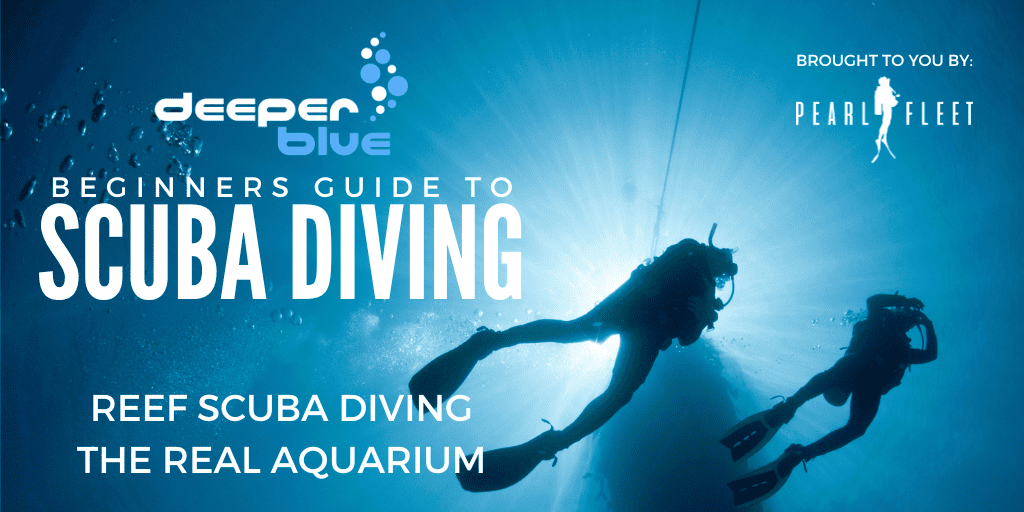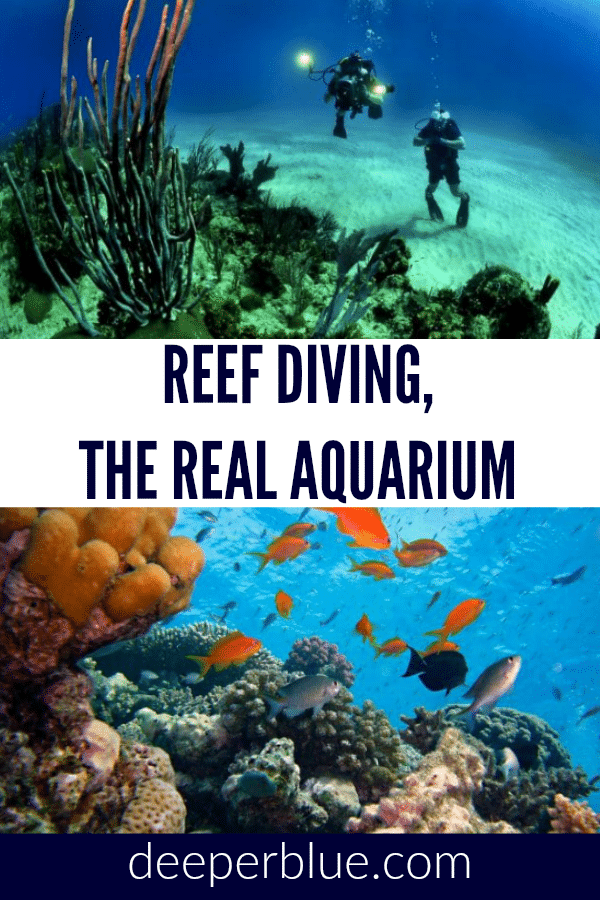This article is part of the Beginners Guide to Scuba Diving
You have been looking forward to this dive. You take a giant step off the dive boat and find yourself in warm crystal clear tropical waters. Soon you start your descent. Around you, there are beautiful tropical fish trying to figure out who is dropping in to see them. You are headed down to a splash of color that extends as far as you can see. You have seen fish like these before when you visited an aquarium, this time it is different. They are around you, no glass, it is their home. You see a turtle graciously moving below you, it seems not to have a care in the world. Welcome to the world of reef diving.
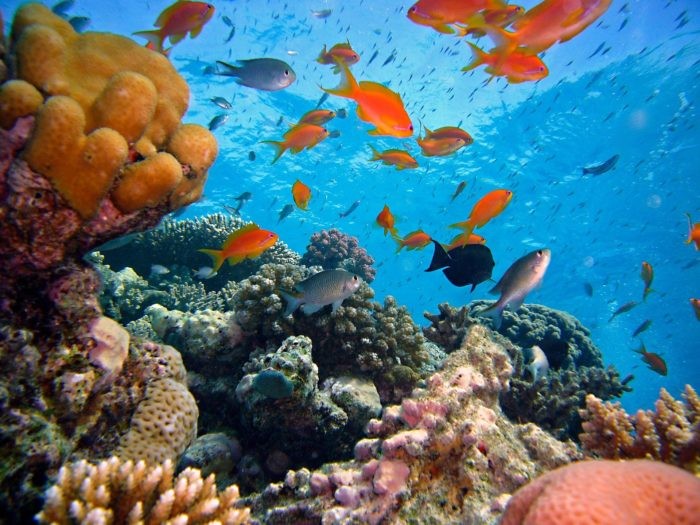
Reef Diving – What is a Reef?
The majority of scuba divers prefer the warm tropical waters to do their diving and coral reefs are the primary focus of their diving. While there are cold-water reefs, the warm-water ones are the ones that get our attention. Many Open Water Divers with their 60 feet/18-meter limitation look longingly at the deeper profiles of the advanced open water and the deep diver.
In reality, some of the best diving is in the waters that are in the realm of the Open Water Diver. Most species of coral rely on algae growth for their own growth and algae require sunlight. While a few coral species will grow as deep as 150 feet /45 meters and a few black corals as deep as 450 feet/ 135 meters, the majority are in less than 100 feet /30 meters. The largest concentrations are often in less than 60 feet/ 18 meters.
What we see as a reef, is a combination of living organisms and the skeleton remains of earlier ones. A living skin if you will. The reef foundation builders are the stony coral polyp. These creatures are very small averaging 1 mm /.04 inches to 3 mm /.11 inches. They are the simplest of creatures, with a few layers of tissue, a mouth, and tentacles. They, with the help of their algae which also gives them their color, excretes a calcium carbonate shell. They will live in this shell and retreat into it when stressed or threatened.
To feed they extend themselves and open to the passing currents, using the tentacles to move food towards their mouths. A polyp in good conditions might create a second shell inside the first. Corals can reproduce asexually and sexually. When they reach a certain size they will create a bud, that becomes a separate coral that attaches and creates their own shell.
Yearly, a coral colony will spawn. About 75% of the species will broadcast spawn, releasing male and/or female gametes into the water. These gametes are positively buoyant so they will float to the surface and hopefully combine. As they grow they will sink and hopefully attach to a suitable location. This event happens simultaneously over many colonies.
When the polyp dies the shell remains, and another polyp or coral larvae (planulae) may attach themselves and grow. Thousands of these polyps will form colonies. In time, larger species of coral will grow. The living portion of the reef is only a thin layer. NOAA Coral Reef Conservation Program (CRCP) has an interesting web page that gives a scientific explanation of coral reef development.
A few interesting facts about coral reefs can give us a better understanding of them. Even a small isolated reef will support a complex ecosystem. Coral reefs are the home of over 25% of the marine life in the world and over 35% will spend at least a portion of their life on the reefs. However, reefs cover only one-quarter of one percent of the ocean floor. The majority of these reefs are found in three areas, the Coral Triangle, the Great Barrier Reef, and Mesoamerican reef systems.
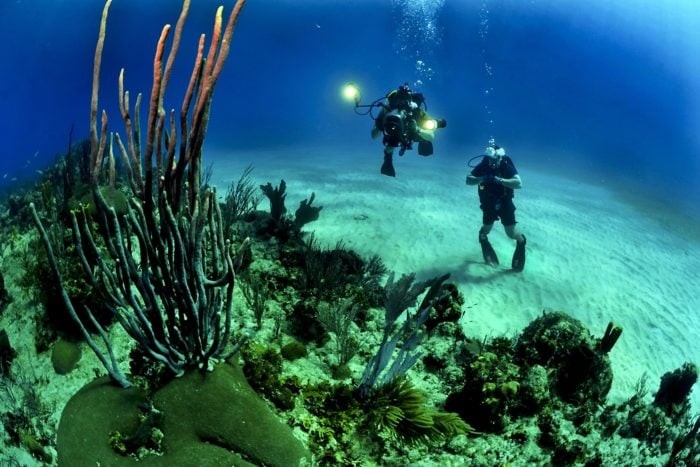
Major Reef Systems
Most of the landmass around continents and islands in the tropical zones will have some form of coral formations. There are three forms of reefs: the barrier reef, the fringe reef, and the atoll. The barrier reefs are the ones we hear the most about, especially the two largest, the Great Barrier Reef of Australia and the Mesoamerican reef system. Both of these reef systems include a number of smaller barriers and fringe reefs.
The Mesoamerican Reef includes the Belize barrier reef. A barrier reef is offshore from the land it is associated with. The face of the reef is on a continental edge that drops down thousands of feet. Behind the reef extending to shore is a shallower area called the lagoon.
The reef helps protect the shoreline which may be many miles/ kilometers away.
The main characteristic of a fringe reef is that it attaches or nearly attaches to the land. The fringe does not have the continental edge that a barrier reef does and if it has a lagoon it is not very large. Any reef that you will dive from the shore or near land will likely be a fringe reef. They are the most common of the reefs.
The Atoll is the least common form of a reef. According to Charles Darwin, the three forms of reefs are simply different stages of development. In an atoll, the reef has formed an oval or circular formation around an island. Changes in seawater depth have caused the island to sink, leaving a ring of coral that is still growing. The inside of the ring is a shallow lagoon often with one opening to the open sea.
We have mentioned the two largest barrier reefs, the Coral Triangle area is the third large concentration of coral. The Coral Triangle represents an area with the greatest biodiversity in the world. Quoting the World Wide Fund For Nature,
“The Coral Triangle, the global center of marine biodiversity, is a 6 million km2 area spanning Indonesia, Malaysia, the Philippines, Papua New Guinea, Timor Leste, and the Solomon Islands. Within this nursery of the seas live 76% of the world’s coral species, 6 of the world’s 7 marine turtle species, and at least 2,228 reef fish species.”
These three areas contain the majority of the world’s corals.
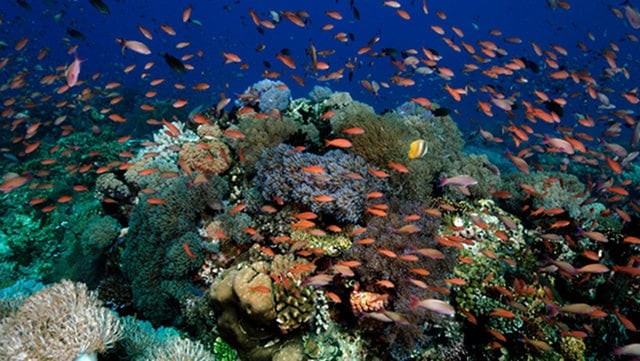
Artificial Reefs
There is one more form of a reef that does not fit the scientific view and that is the artificial reef. Since man has first started going to sea, boats have been sunk. When sitting on the bottom, they attract different marine life who rapidly move in. Seaweed, algae, and other marine life floating in the current may also find these shipwrecks. Coral larvae may also take roots here and start the growth of a colony.
It may take decades before the coral colonies are large enough to support juvenile fish with places to hide, however, the ship can provide that service. In time the shipwreck will be covered with coral and present the diver with an excellent blend of mankind and nature.
Many advocates of artificial reefs will point out there is nothing artificial about them. Man may have placed the substrate in the location, but it was nature that built the reef.
Reefs Need Help
It is a very sad point that mankind has done much to destroy the reef and marine life. Roughly one-quarter of coral reefs worldwide are already considered damaged beyond repair, with another two-thirds under serious threat. As we lose reefs, we also lose the breeding grounds for adults and sanctuaries for juvenile fish. As a diver, we need to make sure that our actions are not adding to the problem. Once a diver sees a healthy reef and compares it to a damaged one, they can see the impact. Learn what you can about marine and coral conservation and do your part, however humble, to help turn this problem around.
Click here for more articles in the Beginners Guide to Scuba Diving
Brought To You By
Our Beginners Guide to Scuba Diving is brought to you by Pearl Fleet. Pearl Fleet invites you to embark on their exquisitely crafted yachts for the finest diving experience the world has to offer. From purposefully designed diving itineraries to high-class amenities, Pearl Fleet’s immersive getaways allow you to indulge in your passion as you journey to world-class diving destinations. You can find out more at pearlfleet.org.

